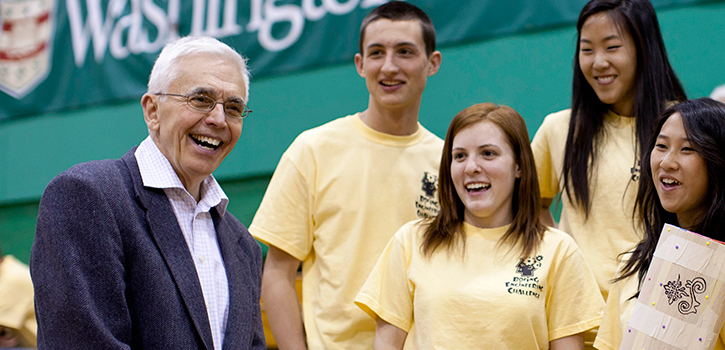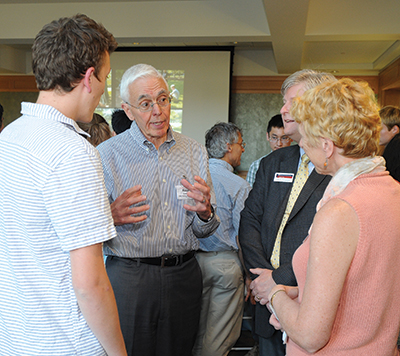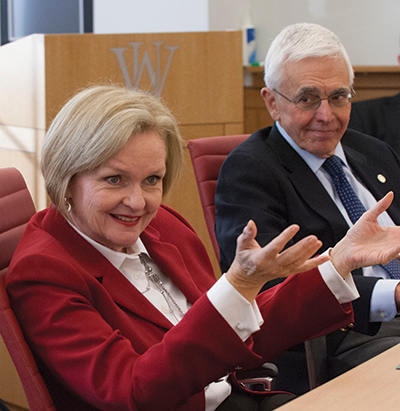Dean Quatrano: Job Well Done

When Ralph S. Quatrano, PhD, steps down as dean June 30, 2015, after five years of leadership, he will be remembered not only for his tremendous success and accomplishments, but also for his congeniality that won the admiration of faculty, staff and students.
As dean, Quatrano has designed and is implementing the school’s ambitious strategic plan, which focuses on creating interdisciplinary collaboration across departments and schools and with other institutions, growing the faculty and student populations, completing the new engineering complex and developing academic programs to prepare engineers for leadership in the 21st century. He is only the 11th dean of the school since 1870.
“Under Ralph’s leadership, the School of Engineering & Applied Science has experienced great success in a number of important areas, including faculty recruitment and sponsored research activities,” Chancellor Mark Wrighton says.
While his hard work has resulted in a very positive outcome, Quatrano says it wasn’t always easy.
“My first experience as a dean was as interim dean of Arts & Sciences; that experience gave me my first insight into university administration and finances, which I avoided for 38 years,” he says, laughing. “But in Engineering, it was clear that every time I looked at something in detail, it needed close attention. The first year was not only correcting and fully understanding what needed to be done, but also assuring the alumni that we do have a strategic plan, we are moving ahead, there is a bright future for Engineering, that we would be hiring faculty and increasing our student population.”
“Under Ralph’s leadership, the School of Engineering & Applied Science has laid out an innovative and far-reaching plan for the school’s expansion, which includes development in the near future of Jubel Hall. I have no doubt that history will show that the last four and a half years have been an era of strategic and thoughtful growth.”
— Chancellor Mark Wrighton, PhD
Quatrano has hired one-third of the current 91 tenured and tenure-track faculty, including two of the five department chairs, and has built a sustainable research infrastructure across all levels of the faculty that has enabled research programs to expand and succeed in each of the departments. During the past year alone, research awards increased by more than 25 percent.
“Ralph took over at a difficult time for the school, breathed new life into it, has led the school back on track and has done a wonderful job,” says Stephen F. Brauer, chairman of Hunter Engineering Co. and of the School of Engineering & Applied Science National Council. “He took a very methodical approach to all the difficult issues the school faced and took them all on and has the school on an even keel now and an upward trajectory.”
Recognizing the university’s priority for a diverse faculty, Quatrano has increased the number of women faculty by 40 percent and hired African-American and Hispanic faculty members.

In addition to more than 20 young faculty members recruited to the school, Quatrano was also instrumental in recruiting senior faculty, including Kathy Flores, PhD, professor and associate chair for materials science; Roch Guerin, PhD, chair of the Department of Computer Science & Engineering and the Harold B. and Adelaide G. Welge Professor of Computer Science; Steven George, PhD, chair of the Department of Biomedical Engineering and the Elvera & William Stuckenberg Professor of Technology & Human Affairs; and Shantanu Chakrabartty, PhD, professor of computer science & engineering; as well as associate professors Jessica Wagenseil, PhD, in mechanical engineering & materials science, and Sanmay Das, PhD, in computer science & engineering.
Under his leadership, student enrollment has increased more than 20 percent to 2,257 this semester, creating the school’s largest-ever undergraduate and graduate classes. He also rejuvenated the Dual Degree Program, which is at its highest enrollment in 20 years. The school is ranked No. 7 for undergraduate student selectivity.
Among other highlights of his tenure, Quatrano has helped build and expand graduate education, including professional master’s programs such as the master of cybersecurity management in collaboration with the Olin Business School and an interdisciplinary doctoral program in materials science and engineering in collaboration with the Graduate School of Arts & Sciences. Under his leadership, 13 new undergraduate and graduate academic programs have been developed.
To promote the application of new discoveries by enhancing the culture of entrepreneurism, Quatrano created the Discovery Competition, an annual competition that gives undergraduate students the opportunity to develop solutions for real-world problems and to compete for $25,000 to help turn their ideas into businesses.

“Ralph has been an inspiring leader and colleague,” says Mahendra R. Gupta, PhD, dean of the Olin Business School and the Geraldine J. and Robert L. Virgil Professor of Accounting and Management. “His willingness to work across disciplines and encourage students and faculty to do the same has led to new collaboration between the engineering and business schools. From dual degree programs to successful startups, Ralph has opened doors — and minds — to the importance of teamwork. We have all benefited from his leadership.”
Engineering’s facilities have expanded under his tenure as well. Preston M. Green Hall, the third building of the new engineering complex on the east end of the Danforth Campus, was completed in 2010, and plans are underway for the fourth building in the complex, to be named Henry A. & Elvira H. Jubel Hall, which will house Mechanical Engineering & Materials Science.
Also during Quatrano’s time as dean, nearly $60 million has been raised as part of Leading Together: The Campaign for Washington University.
“None — and I emphasize none — of this would have been possible without the academic and financial support of university administration,” Quatrano says. “It was their vision as well to build an Engineering school which, in their minds, was just as essential for the future of the university as it was in my mind. It was an across-the-board commitment of the Board of Trustees, the Engineering National Council and higher administration to build the Engineering school, and I valued that very, very much.”
“He reinvigorated the faculty, added new faculty, enlarged the student body, and welded a disparate group of individuals into a smoothly functioning, welcoming environment with purpose and enthusiasm for the future of the school and the future of engineering as a discipline.”
—Katherine Day, Chief Administrator at the Mindlin Foundation
That hard work solving problems and devising ways to improve is something he’ll remember of his time as dean, as well as of the environment and energy level he helped to create in the school.
“I’m proud of the positive outlook that the school, the alumni and the administration have despite the continuing challenges, and the feeling by the faculty and the school that they want to and will succeed in building a better Engineering school and having the will to make that happen,” he says.
Back to Engineering Momentum